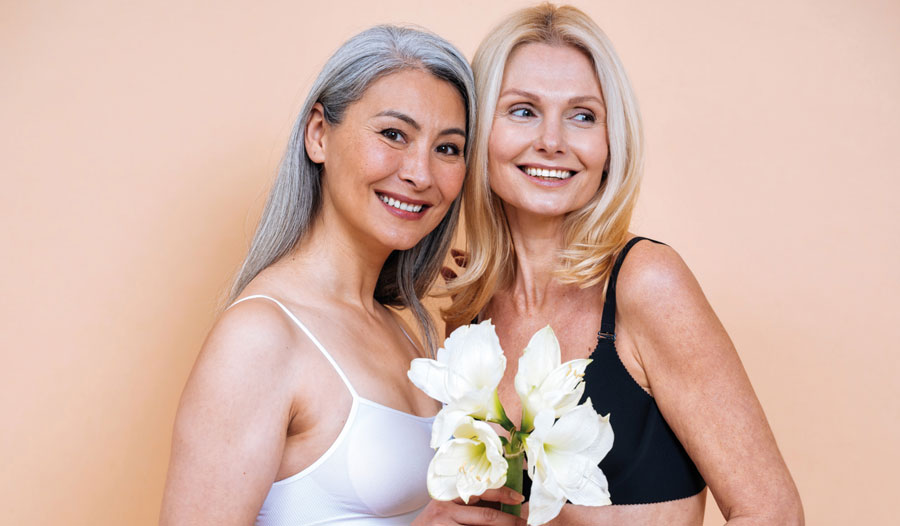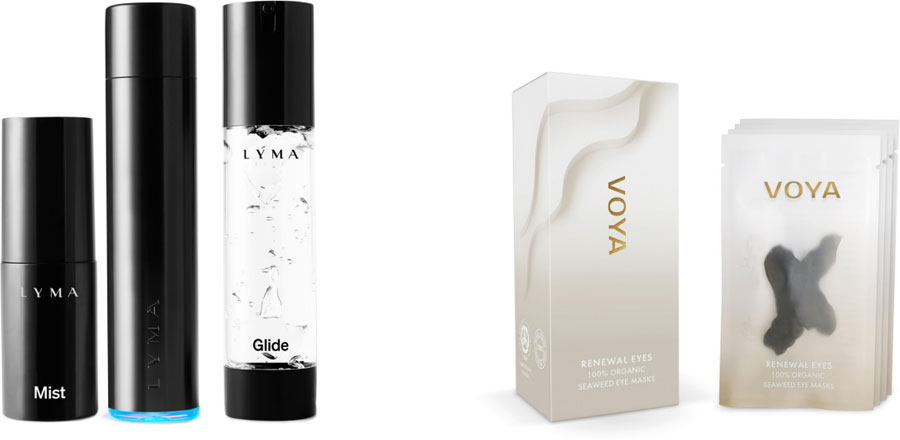
Recently I’ve started doing a monthly Instagram vlog with my pal, Irene Estry.
Irene has been in the fitness and wellness industry for over 40 years, and has the most fantastic approach to fitness and ageing. Now 81, she still actively teaches classes and has a range of attendees from their early 60s to their 90s.
Her philosophy is simple: if you don’t use it, you lose it.
Like Irene, I also believe that age is simply a number, and should not be a barometer for your vitality and wellbeing. I’ve been in the beauty industry for over 25 years, and seen how the fear of ageing has got to the point where some people have fillers pumped into their faces to try and eradicate lines or wrinkles.
But are lines so bad? They help us to show emotions such as joy, sympathy and compassion. For a while now I have been looking into ‘active ageing’ rather than ‘anti-ageing’ – ways you can give vitality, radiance and energy to not only the skin but the spirit. There are plenty of non-invasive options that can help to soften lines and improve the overall appearance and quality of your skin.
No matter what your age or budget, there are easy rituals and routines you can put in place to make you feel good as well as look your best - from stretching and breath work to a morning walk and facial exercises.Here are a few suggestions.
Supplements
According to the Soil Association, a study conducted in 2020 estimated that only 30-40% of soil in Europe is healthy. Soil should act as a huge sponge for carbon and water, but if it becomes degraded it emits greenhouse gases.
Healthy soil is crucial for biodiversity and to grow healthy crops, so if it degrades it can negatively impact the nutritional value of the food we eat.
I asked Phil Beard, a nutritionist and educator at ethical supplement brand Viridian, what we can do if we are worried that we are not getting the nutrients we need.
‘We recommend consuming as many nutrients from food as possible,’ says Phil. ‘However, where there is a nutritional gap or deficiency, which is becoming more common, supplements can be a good option. For optimal nutrition and feeling your best, look for foundation supplements that incorporate a multivitamin, essential fatty acids and a probiotic. Viridian’s Multivitamin Woman 40+ (£29.85, viridian-nutrition.com) can improve your overall nutrient and antioxidant status, while its good balance of omega oils helps maintain your inflammatory balance and skin health, and probiotics regulate the gut.’
I asked him how our nutritional needs change as we get older and what we can do to promote vitality. ‘While good nutrition is essential at any age, there is no one nutrient that is more important than another,’ says Phil. ‘To maintain zest and vitality it’s best to focus on a range of key nutrients. The B vitamins have a critical role in energy production and are commonly found in grass-fed meat, fish, eggs, nuts and seeds. Ensuring adequate vitamin C can support collagen production, which is important for skin function, strong bones and healthy joints. A good intake of omega-3 fatty acids is especially important for skin health. These can be sourced from oily fish or flax seeds. Alternatively, there’s Viridian’s Organic Woman 40+ Omega Oil (£25.75/200ml).
‘Meanwhile, probiotics, or ‘friendly bacteria’, are important for maintaining a healthy microbiome, which supports our overall health. They can be found in fermented foods such as kefir, kimchi or sauerkraut.
‘When it comes to the menopause, there are certain nutrients and herbs that can help to alleviate symptoms. Saffron has been researched for its ability to improve low mood, and herbs which have been shown to reduce the frequency and severity of hot flushes include hops and sage, which contain phytoestrogens. These help the body naturally reduce the impact of declining oestrogen. Other foods naturally rich in phytoestrogens include soya, lentils, red clover, tofu, flax seed and brassicas.’
You can also get supplements in liquid form, so you just pop a few drops under your tongue. Finnish brand Kaapa (kaapamushrooms.com) has created a line of mushroom tinctures to help with various conditions, and is the first company to use ultrasonic-assisted extraction to ensure better bio-availability of the compounds. For example, Lion’s Mane (£25/30ml) can help with brain function and focus due to the neurotrophic properties of its compounds.
Kaapa also makes a tincture from the reishi mushroom (£20/30ml) which has been shown to help with sleep and help to support menopause. Finally, its Chaga mushroom powder (£35) is good for active-ageing, with very high antioxidant levels and DNA-repairing qualities.
 Tweakments
Tweakments’m not a fan of Botox and fillers, so it’s great news that clinics and spas offer lots of choice for people who want to take a more holistic approach to ageing If you love the idea of popping into a clinic to have a pamper, there are various non-invasive treatments available that you can try. ONE Aesthetic Studio in Alderley Edge, Cheshire, offers a Skin Firming Solution (from £900, oneaestheticstudio.com) that uses multiple devices, including focused ultrasound and microneedling. Ouronyx, which has clinics in London and Dubai, also specialises in non-invasive treatments. Its Advanced Procollagen CellFacial (£450/ two hours, ouronyx.com) has been developed with the leading Swiss brand Cellcosmet.
This luxurious experience for your face, neck and hands has immediate results. The skin is instantly smoothed, and the hand ritual softens the skin and promotes stronger nails.
Chill out!
I think that we’ve all seen celebrities on TV or social media plunging themselves into an ice bath or doing a spot of cold-water swimming to help recover after exercise. I tend to finish my daily hot shower with a 30 to 60-second blast of cold water, which leaves me feeling energised. A cold water rinse is also supposed to help boost circulation to the scalp and promote shiny hair by smoothing down the hair shaft.
If you fancy taking the plunge and trying a spot of cold-water swimming, there are lots of lovely places to choose from in the UK, from Hampstead Heath Lido in London to Loch Morlich, near Aviemore in Scotland. I would suggest getting your body used to these kind of temperatures first by taking cold showers. It’s also essential that you wear the right gear for open-water swimming, such as a neoprene swimming cap, gloves and footwear to help retain body heat. Also, it’s a good idea for go for a brightly coloured cap so that you can be easily seen.
One other thing I’ve tried is Whole Body Cryotherapy at Chillglow in Hale, Cheshire, (£99 for four sessions, chillglow.co.uk). Cryotherapy is starting to become incredibly popular with the public - before, it was only used to help elite athletes to recover from injuries.
You step into a booth that is chilled to minus 87C wearing shorts, a vest, a thermal hat, gloves, socks and footwear for three minutes. Once you’ve had a few sessions and your body is accustomed to the treatment, you may want to extend the length of your sessions. I found the cold was crisp, not damp, while the slow deep breathing I practised while in the booth relaxed me. There have been various studies into the benefits of cryotherapy, from pain relief to helping boost the immune system. I felt absolutely invigorated, and will definitely be back for more.

At-home treatments
While a lot of people love going to a spa or clinic, there is a growing market for at-home treatments. This could mean a therapist or other professional coming to your home or doing it yourself.
Technology is moving so quickly that there are now skincare devices that are safe and effective for the general public use. A perfect example is the LYMA Laser (£1,999, lyma.life). The handheld device delivers a cold laser light deep within the dermis, helping skin cells ‘rejuvenate’ and ‘restore’. So, it’s perfect for hyperpigmentation, sagging skin, acne, thread veins, lines and even ‘crow’s feet’ around the eyes.
There are so many ways to use this handy tool, but you must be able to dedicate three to 20 minutes every day to using it, because consistency is key if you want to see and feel the difference. It was even used at this year’s Academy Awards on celebrities including Jennifer Aniston and Emma Roberts by celebrity facialist Joanna Czech.
A friend of mine has bought one to address her pigmentation issues from sun exposure, and she insists it has made a difference. I’ve been using one for a couple of weeks now along my jawline and on my pigmentation. I use it for three minutes in each area while I’m watching TV in the evening, and it’s an easy addition to my skincare routine. The biggest problem is remembering to do it, but I’m determined to keep going, to see what kind of difference this innovative device can make.
As I said, consistency is key for cumulative benefits, but it’s an easy gadget to pack and the charge lasts for a long time. I love the Oxygen Mist that comes with it, but I’m not a big fan of the Oxygen Glide, which you apply to the area being treated. I found it a bit sticky, although LYMA founder Lucy Goff says she uses it as a 20-minute face mask to give the appearance of ‘an oxygen facial from a clinic’. I am going to try the laser on some of my clients, using slow sweeping movements for 10 minutes on each side of the face and 10 minutes on the neck to boost the natural glow to the skin.
Masks can also be a valuable tool in pampering and revitalising the skin, from spooky-looking LED full-face masks to biodegradable sheet masks. The delicate eye area tends to need some TLC, so try Voya Renewal Eye Masks (£30 for four pairs, voya.ie). They are made from hand-harvested Irish Laminaria digitata seaweed, and are designed to hydrate, cool, soothe, reduce puffiness and help with dark circles. An independent study showed that seaweed boosted collagen production by a staggering 200%, while helping the body to fight premature-ageing free radicals by 122%!
◆ Pictures: Adobe Stock
◆ Find our expert stylist Armand Beasley’s monthly column of beauty advise in every issue of The Lady Magazine.







